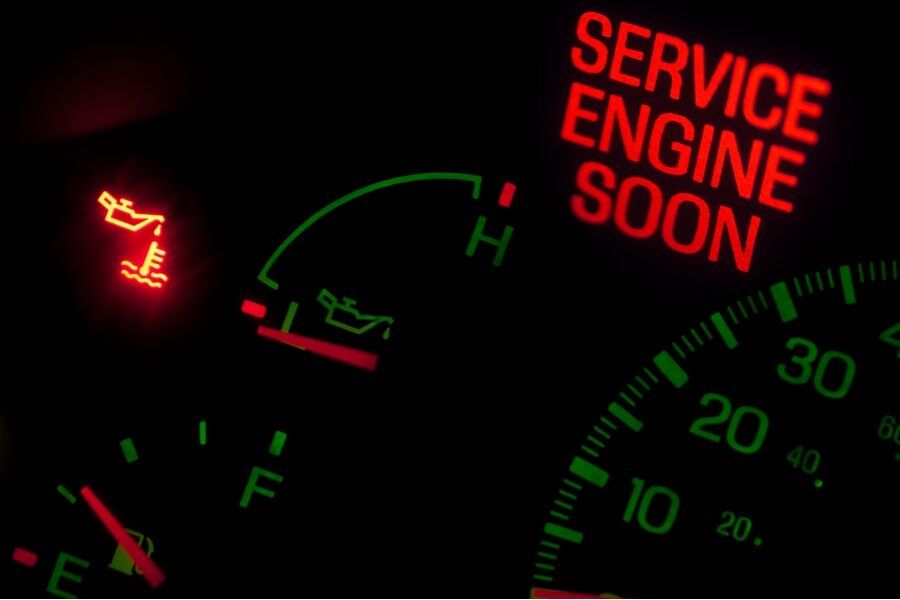The check engine light has been instilling driver panic since day one. The ominous orange glow – sometimes accompanied by a chime – is cause for alert but is rarely the death sentence drivers assume. There are a number of reasons your dashboard might sport a check engine light in Downriver Michigan. Generally benign, the causes for a check engine light are myriad and often misunderstood. Read on and take a look at some of the common causes and cures for check engine lights.
Faulty Catalytic Converter
Let’s get the big one out of the way: the catalytic converter, or “cat” is both costly, and integral to your car’s emissions system. Nearly every roadgoing car has at least one catalytic converter, which is responsible for scrubbing engine exhaust of many harmful pollutants. While required by law in nearly every state, they are not critical to the mechanical function of the car, and as such a faulty catalytic converter is probably not going to leave you stranded. It should be noted that although a faulty catalytic converter is not catastrophic in and of itself, it can be (and often is) a sign of other failing systems that are critical to engine function.
They are expensive however, and a faulty cat can be a roadblock to passing inspection. Because catalytic converters rely on precious metals like platinum, the cost for replacement can be high. As the catalytic converter degrades, it becomes less efficient. When your car detects a spike in hydrocarbons (the stuff that pollutes) exiting the tailpipe, it signals a warning in the from of a check engine light.
Faulty Oxygen Sensors and Mass Airflow Sensor
The mass airflow sensor is responsible for calculating the air entering the engine, which helps the car’s computer establish the amount of fuel to burn for proper performance. Should it fail, a check engine light will be displayed. The car may also revert to a sort of “default” mode, which translates to reduced power.
At the opposite end, the oxygen sensors continuously test the air exiting the engine and report back to the car’s central computer. Most cars have at least two oxygen sensors; one “upstream” (before the catalytic converter), and one downstream (after the catalytic converter). Together, these sensors indicate both the effectiveness of the catalytic converter, as well as whether the engine is burning fuel at a proper ratio.
Should one of these sensors fail, you’ll probably see a check engine light. There may also be a noticeable decrease in power, but your car is unlikely to burst into flames or seize. Still, it’s best to get them checked at your earliest convenience.

Worn Spark Plug Wires
The spark plug wires deliver electrical current to the spark plugs, which are responsible for igniting the air and fuel that keeps your car moving. Were all the wires to be severed, the car would not start. Because nearly every car on the road today uses at least four cylinders, if a single wire were damaged the engine would run albeit improperly. Fuel would be introduced to a cylinder that would then exit unburned, and the result is reduced power, increased emissions, and a guaranteed check engine light.
The Gas Cap
It’s good you read this far, because the gas cap should be the first place you start. If your car displays a check engine light, simply tightening the gas cap and continuing to drive for a few miles just might make it go away.
Your car’s fueling system requires pressure to properly feed the engine, and a loose gas cap doesn’t allow it to build. An improperly tightened gas cap also allows fuel vapors to escape. This pollutes. Your car’s check engine light is often tied to a malfunction that in some way results in more pollution.
Can I Drive with a Check Engine Light?
In most instances, you can indeed drive with a check engine light. Bear in mind your car will not be operating at peak performance, and if left ignored could result in costly repairs down the road. Fortunately, it’s pretty easy for a trained technician to at least diagnose the cause of the light. If your car has a check engine light you can certainly continue with your day, but it’s best to schedule a service appointment at your earliest convenience. The exception here is a blinking check engine light. If the light is blinking it indicates a problem of greater severity that requires immediate attention. If your check engine light is blinking, it’s best to pull over as early as safely possible.
Check engine lights are a motorist’s worst nightmare. But here at Good Care Auto, we understand check engine lights and the urgency to get back on the road. Our team of skilled ASE-certified technicians utilize the latest diagnostic equipment to provide accurate, reasonable estimates and fast turnaround. From spark plugs to sensors, our staff provides friendly, expert service and can promptly diagnose any check engine light for nearly all makes and models. Don’t fear the orange glow – call (734) 285-1188 and schedule an appointment with Good Care Auto today!
